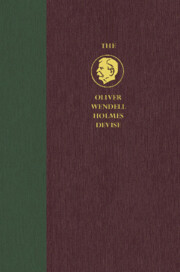Book contents
- The Hughes Court
- The Oliver Wendell Holmes Devise History of the Supreme Court of the United States
- Additional material
- Additional material
- The Hughes Court
- Copyright page
- Contents
- Acknowledgments
- Preface
- Table of Cases
- Introduction
- Part I The Opening Years
- Part II Continuities
- Section A: Administrative Law
- Section B: Civil Liberties and Civil Rights
- Section C: Justiciability
- Chapter 29 Basic Concepts of Justiciability
- Chapter 30 Sovereign Immunity and Political Questions
- Chapter 31 Regulating Access to the National Courts
- Chapter 32 Erie
- Chapter 33 Erie’s Legacy
- Chapter 34 Form and Style in Statutory Interpretation
- Part III New Approaches Begin to Emerge
- Historiographical Essay
- Index
Chapter 29 - Basic Concepts of Justiciability
from Section C: Justiciability
Published online by Cambridge University Press: 13 January 2022
- The Hughes Court
- The Oliver Wendell Holmes Devise History of the Supreme Court of the United States
- Additional material
- Additional material
- The Hughes Court
- Copyright page
- Contents
- Acknowledgments
- Preface
- Table of Cases
- Introduction
- Part I The Opening Years
- Part II Continuities
- Section A: Administrative Law
- Section B: Civil Liberties and Civil Rights
- Section C: Justiciability
- Chapter 29 Basic Concepts of Justiciability
- Chapter 30 Sovereign Immunity and Political Questions
- Chapter 31 Regulating Access to the National Courts
- Chapter 32 Erie
- Chapter 33 Erie’s Legacy
- Chapter 34 Form and Style in Statutory Interpretation
- Part III New Approaches Begin to Emerge
- Historiographical Essay
- Index
Summary
Felix Frankfurter invented the field of federal jurisdiction. It concerned the occasions for the proper exercise of federal judicial power under Article III. The Hughes Court endorsed the Declaratory Judgment Act as a mechanism for efficient dispute adjudication. And, though the Court did not follow his advice consistently, in Ashwander v. TVA Justice Brandeis developed a comprehensive list of rules that should limit the number of cases in which the federal courts exercised their power. Among those doctrines was a newly invigorated law of standing that, Brandeis and Frankfurter may have hoped, would have insulated New Deal legislation against constitutional challenge.
Keywords
- Type
- Chapter
- Information
- The Hughes CourtFrom Progressivism to Pluralism, 1930 to 1941, pp. 747 - 783Publisher: Cambridge University PressPrint publication year: 2022

